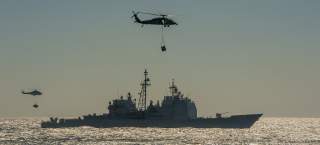Could China's Aircraft Carrier Take on America's Navy?
Yes, but it will take a few decades.
China’s sole carrier Liaoning is operating in the South China Sea with a full-complement of aircraft along with five escorting vessels for the first time this week. The vessels have been conducting exercises and testing weaponry at sea in a display of Beijing’s growing military might—causing concern amongst China’s neighbors.
“The formation, which is on a ‘cross-sea area’ training exercise, involved J-15 fighter jets, as well as several ship-borne helicopters,” the Chinese Defense Ministry stated on its website. “Complex hydrological and meteorological conditions in the South China Sea as well as a cold front in area have posed some challenges, but the source said the drill provided important experience in the build-up of combat capability of the aircraft carrier formation.”
Video footage from the Chinese exercises look impressive, but such footage always does.
But just because Beijing managed to sail a carrier battle group out into the ocean beyond its local seas does not mean that China has a fully operational carrier capability despite the official assertions to the contrary. The Liaoning’s deployment is a test—a learning experience that Beijing can use to refine its training and procedures.
As one former People’s Liberation Army Navy commander, Chen Yueqi, described, Liaoning’s voyage—along with its escorts—is an important first step in demonstrating that China has the ability to deploy an integrated carrier strike group. The Chinese will have to validate their command and control, their training and the capability of their ships to operate together, he said.
The Pentagon says in its 2015 report on Chinese military power that Liaoning and its air wing, as currently configured, are not really capable of projecting power over great distances. The ship is too small and is best suited for providing fleet air defense and extending air cover over a fleet operating far from shore. “The Liaoning will not enable long-range power projection similar to U.S. Nimitz-class carriers,” the report states.
But Liaoning is not really meant to be a match for the U.S. Navy’s super carriers. China is still the initial stages of learning how to operate jets at sea, but having Liaoning offers Beijing an important learning tool. It took the United States Navy decades—and a lot of blood and treasure—to fully master carrier aviation and it will take China a while to get a hang of it too. As such, Liaoning and its battle group are essentially operational test and evaluation assets.
The bottom line that while China is developing a battle group to go to sea with its flattop, but it’s more than about just the hardware. Beijing has to develop the training and procedures so that the PLAN can operate as a unit at sea—which is what the Chinese appear to be doing. However, it will take time for the PLAN to get to level of competency where it can have any real shot at going head-to-head with the U.S. Navy in the Western Pacific. Will they eventually get there? Possibly, but it might take decades.
Dave Majumdar is the defense editor for The National Interest. You can follow him on Twitter: @davemajumdar.

